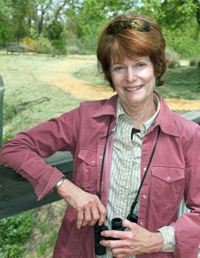Ann Brice

Ann Brice is an ecologist who has served for years on the Board of Directors of the Yolo County Flood Control and Conservation District and was the founding executive director the Cache Creek Conservancy in 1996.
It was up to the Cache Creek Conservancy to appropriate the land donated by Teichert mining company in 1996 and turn it into a viable ecosystem. What was that like?
The Conservancy was originally envisioned as a means of implementing restoration projects where there had been gravel mining. When I was working here, we were finding places where there had been big gravel pits and planting trees and connecting them up to the creek, just trying to make them more attractive for the future. We always involved school children and the community in the planting.
What was your reaction when you were offered the position of Executive Director?
When I was first asked whether I would be interested in heading the brand new Cache Creek Conservancy, I really thought long and hard about it, because when you drive out along this lower portion of the creek, it’s not all that attractive. I thought, “I don’t know, this looks like almost an impossible task.” Then one day I was out by myself at the bridge over the creek and an osprey flew by. And really, I’m not a religious person, but I felt like it was a sign to me. Such a wonderful raptor, and you don’t see it in an area that is really unhealthy. It was as if it was saying to me, there’s hope! We can do this! The next week I said I would take the job. And that’s a true story.
What priorities did the Conservancy uphold in deciding how the Preserve land should be restored?
There was one thing that was really important to me to rearrange. Teichert has a big conveyer belt that conveys gravel to the other side of the creek. It was originally slated to run right through this property. Teichert was hopeful that it could be educational, but I felt that it was intrusive. There was a lot of negotiating about that, and Teichert really did the right thing. It costs them quite a lot more money to run the conveyer belt south and around, but that’s what they did, leaving this piece of property intact. So we are very fortunate.
What would you like to tell us about wildlife here at the CCNP?
The Cache Creek Nature Preserve… really provides an amazing haven for wildlife. When water was first put in the old gravel-mining pit it looked just barren. It looked like the top of a volcano; it was just water and nothing. Now that the planting has grown up and the birds know about it, they come, they nest, and they are raising young! There are always the sounds of nature around. It’s really gratifying to see.
Why is the Cache Creek Nature Preserve important to the community?
A place like the Cache Creek Nature Preserve is really invaluable to the community. I sometimes think that Woodland gets a little gypped on things like this. Woodland hasn’t really had a spot of its own where people could just come out and enjoy being in nature and not have to worry about the all terrain vehicles that go in the creek, and people hunting and all those things. This is a perfect spot for peaceful nature watching. It is more than just Woodland’s, it’s regional, but it is Woodland’s special place. My only wish is that it was open to the public more often than it is. Maybe that will happen someday.
What do you see as being the future of the Cache Creek Nature Preserve?
The mission of the Cache Creek Conservancy as an organization is to consider the whole lower 15 miles of the creek and to try to improve all areas where there was gravel mining, in order to improve the degraded environment. This preserve is looking wonderful now, but I hope that the Conservancy with its funding from the gravel companies will begin to work on other sites that need restoration. My dream for the future would be that the whole lower 15 miles of the watershed would look like the upper relatively untouched parts of the watershed.